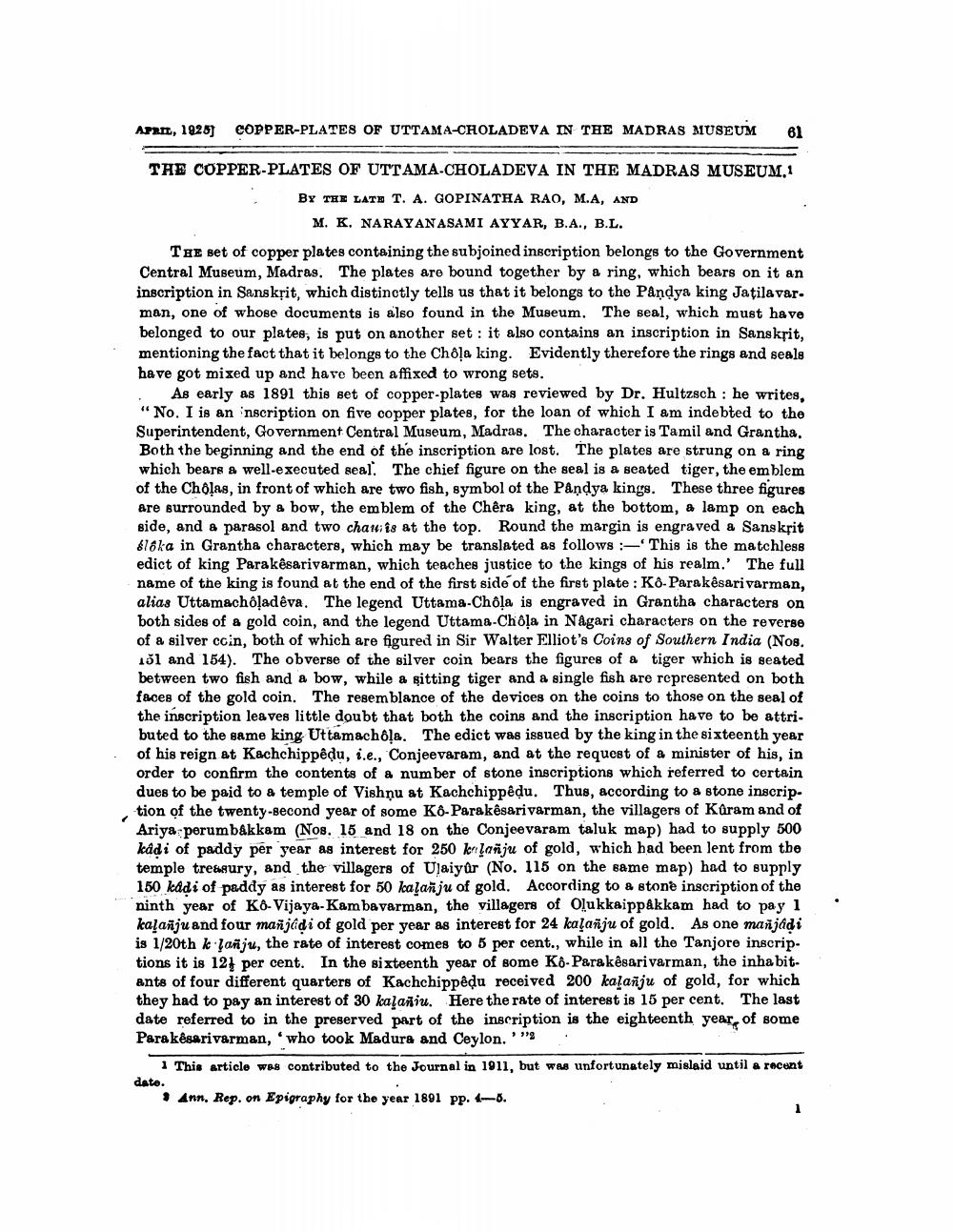________________
APRE, 1929) COPPER-PLATES OF UTTAMA-CHOLADEVA IN THE MADRAS MUSEUM
61
THE COPPER-PLATES OF UTTAMA-CHOLADEVA IN THE MADRAS MUSEUM.1
BY THE LATE T. A. GOPINATHA RAO, M.A, AND
M. K. NARAYANASAMI AYYAR, B.A., B.L. THE Bet of copper plates containing the subjoined inscription belongs to the Government Central Museum, Madras. The plates are bound together by a ring, which bears on it an inscription in Sanskrit, which distinctly tells us that it belongs to the Påndya king Jatila var. man, one of whose documents is also found in the Museum. The seal, which must have belonged to our plates, is put on another set : it also contains an inscription in Sanskrit, mentioning the fact that it belongs to the Chola king. Evidently therefore the rings and seals have got mixed up and have been affixed to wrong sets. • As early as 1891 this set of copper-plates was reviewed by Dr. Hultzsch : he writes, "No. I is an inscription on five copper plates, for the loan of which I am indebted to the Superintendent, Government Central Museum, Madras. The character is Tamil and Grantha. Both the beginning and the end of the inscription are lost. The plates are strung on a ring which bears & well-executed seal. The chief figure on the seal is a seated tiger, the emblem of the Cholas, in front of which are two fish, symbol of the Pandya kings. These three figures are surrounded by a bow, the emblem of the Chêra king, at the bottom, & lamp on each side, and a parasol and two chauis at the top. Round the margin is engraved a Sanskrit 816ka in Grantha characters, which may be translated as follows :- This is the matchless edict of king Parakesarivarman, which teaches justice to the kings of his realm.' The full name of the king is found at the end of the first side of the first plate : Ko-Parakesarivarman, alias Uttamachôļadēva. The legend Uttama Chola is engraved in Grantha characters on both sides of a gold coin, and the legend Uttama-Chola in Nagari characters on the reverse of a silver coin, both of which are figured in Sir Walter Elliot's Coins of Southern India (Nos. 151 and 154). The obverse of the silver coin bears the figures of a tiger which is seated between two fish and a bow, while a sitting tiger and a single fish are represented on both faces of the gold coin. The resemblance of the devices on the coins to those on the seal of the inscription leaves little doubt that both the coins and the inscription have to be attri. buted to the same king Uttamachôla. The edict was issued by the king in the sixteenth year of his reign at Kachchippêdu, i.e., Conjeevaram, and at the request of a minister of his, in order to confirm the contents of a number of stone inscriptions which referred to certain dues to be paid to a temple of Vishnu at Kachchippedu. Thus, according to a stone inscription of the twenty-second year of some Kô-Parakêsarivarman, the villagers of Kuram and of Ariya perumbakkam (Nos. 15 and 18 on the Conjeevaram taluk map) had to supply 500 kad i of paddy per year as interest for 250 kr Lanju of gold, which had been lent from the temple treasury, and the villagers of Ulaiyar (No. 115 on the same map) had to supply 150 kad i of paddy as interest for 50 kalanju of gold. According to a stone inscription of the ninth year of K6. Vijaya-Kam bavarman, the villagers of Olukkaippakkam had to pay 1 kalanju and four mañjadi of gold per year as interest for 24 kasanju of gold. As one manjadi is 1/20th k Janju, the rate of interest comes to 5 per cent., while in all the Tanjore inscriptions it is 121 per cent. In the sixteenth year of some Ko. Parakesarivarman, the inhabit. ants of four different quarters of Kachchippedu received 200 kalanju of gold, for which they had to pay an interest of 30 kalaniu. Here the rate of interest is 15 per cent. The last date referred to in the preserved part of the inscription is the eighteenth year, of some Para kêsarivarman, 'who took Madura and Ceylon.'' '
This article was contributed to the Journal in 1911, but was unfortunately mislaid until a recent date.
Ann. Rep. on Epigraphy for the year 1891 pp. 1-3.




